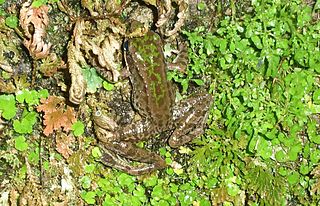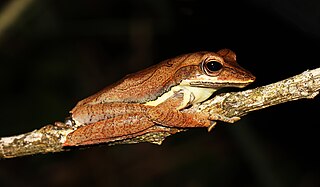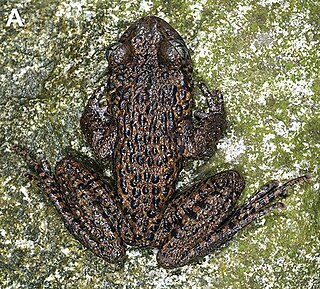
Odorrana aureola, also known as the Phu Luang cliff frog or gold-flanked odorous frog, is a true frog species from northeastern Thailand. The specific name aureola is Latin and means ornamented with gold, in reference to the characteristic yellow markings on the limbs and flanks of this frog. It is notable for its ability to change color between green and brown, according to the surroundings.
Plectrohyla pokomchi is a species of frogs in the family Hylidae. It is endemic to central and eastern Guatemala and known from Sierra de Xucaneb and Sierra de las Minas at elevations of 1,400–1,900 m (4,600–6,200 ft) above sea level. Its specific name refers to the Poqomchi' people, a group of Indian people from the Guatemalan highlands. Common name Rio Sananja spikethumb frog has been coined for it.
Phrynobatrachus keniensis is a species of frog in the family Phrynobatrachidae. It is found widely in the highlands of Kenya. It is also recorded from Mount Meru in northern Tanzania, but this might represent a different species. Common names Kenya River frog and upland puddle frog have been coined for it.
Odorrana absita is a species of frog in the family Ranidae. It is found in southern Laos and central Vietnam. It was originally described in genus Huia. Its type locality is Xe Sap National Biodiversity Conservation Area in southern Laos.
Huia melasma is a species of frogs in the family Ranidae. It is endemic to western and northern Thailand and known from Kanchanaburi, Prachuap Kiri Khan, and Chiang Mai Provinces.
Cornufer macrosceles is a species of frog in the family Ceratobatrachidae. It is endemic to the island of New Britain, Papua New Guinea. It is only known from the Nakanai Mountains in the central part of the island. Only three specimens are known. Common name Ti wrinkled ground frog has been coined for the species.

The Amami tip-nosed frog is a species of frog in the family Ranidae. It is endemic to the Amami Islands, a part of the Ryukyu Islands, Japan. Specifically, it is known from the islands of Amamioshima and Tokunoshima.
The Tonkin frog is a species of frogs in the family Ranidae. It is found in northern Vietnam and in adjacent southern China. The specific name is derived from Bac Bo, the Vietnamese name for northern Vietnam, as the species was first described from there.
Amolops daorum is a species of frog in the family Ranidae. It is known from its type locality in the vicinity of Sa Pa in northern Vietnam near the Chinese border, Hong Kong, and Houaphanh Province in eastern Laos; presumably it also occurs the intervening areas. The Hong Kong record is considered suspicious, however. Moreover, some sources, notably the IUCN Red List of Threatened Species, regard this species as a junior synonym of Amolops mengyangensis.
Large odorous frog, Odorrana graminea, is a species of frog in the family Ranidae. It is found in southern China (from southern Anhui and northern Zhejiang west to extreme southern Gansu, southeastern Sichuan, and southern Yunnan to the border of Vietnam, Laos and Myanmar, although it has not yet been recorded in the latter two countries. Its type locality is the Wuzhi Mountain in Hainan. Until the revision of "Rana livida" in 2003, this frog was considered a synonym of Odorrana livida. The species occurs near fast-flowing rivers and streams in montane tropical forests.
Odorrana jingdongensis is a species of frogs in the family Ranidae. It is known from southern China and northern Vietnam, though it quite likely also occurs in the adjacent areas in Laos and in Myanmar. Its name refers to its type locality, Jingdong Yi Autonomous County in Yunnan. Common name Jingdong frog has been coined for it.

Odorrana livida, also known as the green mountain frog, green cascade frog, Tenasserim frog, bright frog, large odorous frog, or large-eared rock frog, is a species of frog in the family Ranidae. It is known with certainty only from its neotype locality at the Dawna Range in Myanmar, near the border to Thailand, but molecular data suggest that it is present in northeastern India and in peninsular Thailand too, while records from China refer to other species. In much of the literature, this species has been confused with other species, including Odorrana graminea.
Odorrana morafkai is a species of frogs in the family Ranidae. It is found in eastern Cambodia, southern Laos, and central Vietnam. This frog is highly unusual because it turns from its daytime green color to brown at night.
Odorrana supranarina is a species of frog in the family Ranidae. It is endemic to Ryukyu Archipelago, Japan, and is known from the islands of Ishigaki and Iriomote, both in the Yaeyama Group. The specific name supranarina refers to the large size of this species —at the time of the species description, it was the largest member of the so-called Rana narina complex. Common name greater tip-nosed frog has been coined for it.

Odorrana swinhoana is a species of frog in the family Ranidae. It is endemic to Taiwan and widely distributed in hilly areas below 2,000 m (6,600 ft). It is named for Robert Swinhoe, a British naturalist and diplomat. Its common names include Swinhoe's brown frog, Bangkimtsing frog, brown-backed odorous frog, Taiwan odorous frog, and Taiwan sucker frog.
Odorrana utsunomiyaorum is a species of frog in the family Ranidae. It is endemic to Ryukyu Archipelago, Japan, and is known from the islands of Ishigaki and Iriomote, both in the Yaeyama Group. The specific name utsunomiyaorum honours Taeko and Yasuaki Utsunomiya for their contributions to clarifying the amphibian fauna of the Yaeyama Group.

Taruga fastigo is a species of frogs in the family Rhacophoridae. It is endemic to Sri Lanka and only known from its type locality, Morningside Estate near Rakwana. Prior to its description in 2001, it was confused with Polypedates eques.
Phrynopus oblivius is a species of frogs in the family Craugastoridae. It is endemic to central Peru and only known from near its type locality near Maraynioc, in the Tarma Province, Junín Region, at about 3,210–3,220 m (10,530–10,560 ft) asl. It is known from a collection in 2005; there has been no later surveys for the species.
Pseudophilautus simba is a species of frogs in the family Rhacophoridae endemic to Sri Lanka. It is only known from its type locality in the Morningside Forest Reserve, adjacent to the Sinharaja Forest Reserve, near Rakwana, southern Sri Lanka.

Oreolalax longmenmontis is a species of frog in the family Megophryidae. It is endemic to Sichuan, China, and is only known from its type locality in the White River National Nature Reserve, Pengzhou City. The type locality is in the central part of the Longmen Mountains. Accordingly, common name Longmen Mountains toothed toad has been proposed for this species.






